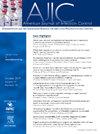确定儿科门诊和程序性护理环境的感染预防人员需求。
IF 3.8
3区 医学
Q2 INFECTIOUS DISEASES
引用次数: 0
摘要
背景:最近的分析表明,在考虑到复杂性和非住院地点后,现有的感染预防师(IP)人员配备比例并不能反映机构需求的范围。我们试图确定目前的 IP 人员配备水平,以应对儿科门诊和手术操作的复杂性和范围:该需求评估改编自 Bartles 等人(2018 年)之前的分析。我们对负责门诊/手术地点的 IP 进行了调查,内容涉及临床复杂性指标和每周用于 IP 活动的估计小时数。报告的时数用于计算IP每周的总时数和相关的全职当量(FTE):一半(118/237)接受调查的地点/服务至少报告了一项复杂性指标,近 9%(21/237)报告了 3 项或更多复杂性指标。感染预防控制人员每周花费 181.0 小时专注于门诊/手术地点,相当于 4.5 个全职员工:讨论:感染预防与控制部门的领导利用这些发现,成功地为该部门增加了 4 个 IP 全职员工。讨论:感染预防和控制部门的领导利用这些发现,成功地为该部门增加了 4 名 IP 全职员工。这些全职员工将增加门诊/手术 IP 支持,改善监管准备,并增加质量改进措施:评估儿科门诊/手术场所的复杂性和范围可以作为一种有价值的工具,用于(1)在系统层面倡导增加整体 IP 人员配备,以及(2)确定 IP 时间和资源在这些场所的分配。本文章由计算机程序翻译,如有差异,请以英文原文为准。
Determining infection prevention staffing needs for the pediatric ambulatory and procedural care setting
Background
Recent analyses suggest that existing infection preventionist (IP) staffing ratios do not reflect the scope of institutional needs after accounting for complexity and non-inpatient locations. We sought to determine the current IP staffing level required to address the complexity and scope of our pediatric ambulatory and procedural operations.
Methods
This needs assessment was adapted from previous analyses by Bartles et al (2018). We surveyed IPs covering ambulatory/procedural locations regarding clinical complexity indicators and estimated hours per week spent engaged in IP activities. The reported hours were used to calculate total IP hours per week and associated full-time equivalents (FTEs).
Results
Half (118/237) of surveyed locations/services reported at least 1 complexity indicator, while nearly 9% (21/237) reported 3 or more complexity indicators. IPs spent 181.0 h/wk focused on ambulatory/procedural locations, equating to 4.5 FTEs.
Discussion
Infection prevention and control leadership used these findings to successfully add 4 IP FTEs to the department. These FTEs will allow increased ambulatory/procedural IP support, improved regulatory readiness, and increased quality improvement initiatives.
Conclusions
Assessing the complexity and scope of pediatric ambulatory/procedural locations can be a valuable tool for (1) advocating for overall IP staffing increases at a system level and (2) determining the distribution of IP time and resources in such locations.
求助全文
通过发布文献求助,成功后即可免费获取论文全文。
去求助
来源期刊
CiteScore
7.40
自引率
4.10%
发文量
479
审稿时长
24 days
期刊介绍:
AJIC covers key topics and issues in infection control and epidemiology. Infection control professionals, including physicians, nurses, and epidemiologists, rely on AJIC for peer-reviewed articles covering clinical topics as well as original research. As the official publication of the Association for Professionals in Infection Control and Epidemiology (APIC)

 求助内容:
求助内容: 应助结果提醒方式:
应助结果提醒方式:


